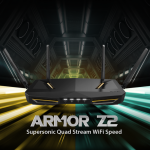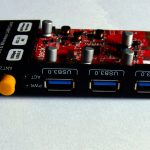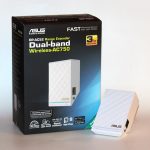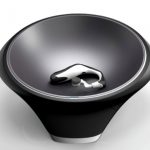ZyXEL unveils ARMOR Z2 AC2600 802.11ac MU-MIMO Dual-Band Wireless Gigabit Router

When buying a router for your home, there are many things to consider. While price is always a factor, you never want to save money by going with a low-quality offering. You should do your research and get the best hardware for your budget -- while sticking with a reputable brand, of course.
ZyXEL is not a household name, but the Taiwan-based company does offer solid hardware at affordable prices. When I've needed something like a network switch or USB Wi-Fi dongle, I have chosen its products due to low prices, but have been very satisfied with the quality. I've never tried its wireless routers, but today, the company announces its newest such model -- the ARMOR Z2 AC2600 -- and it has me intrigued.
Qualcomm and TDK announce joint venture valued at $3bn

Qualcomm and Japanese tech firm TDK Corporation have announced a joint venture, valued by Reuters at approximately $3 billion (£2bn).
The new company, named RF360 Holdings, will be building modules needed to communicate wirelessly with mobile devices and IoT devices. Those modules include the RF front-end (RFFE) and RF filters, the two companies said in a press release.
EFF vs John Legere

John Legere waved his magic spin-control wand today, following accusations from Google and the EFF—that's Electronic Frontier Foundation to you, Bud—that the cellular carrier throttles video streams in violation of Net Neutrality rules. In a video, T-Mobile's CEO calls the throttling accusations a "game of semantics" and "bullshit".
"We give our customers more choices, and these jerks are complaining?" Legere blasts. "Who the Hell do they think they are? What gives them the right to dictate what my customers or any wireless consumer can choose for themselves?" I wonder, too.
Google gives great WiFi with OnHub [review]

One word describes Google's wireless router: Fantastic! That should be enough said, but one of my colleagues asked me how much OnHub costs. He bristled at $199.99, calling it too much. So, okay, let's do a real review that explains the magic that Google and partner TP-LINK accomplish with this remarkable router. But I warn you now: Buying one, even for two C notes, isn't easy. This thing is out of stock most everywhere, as it has been for weeks.
Simply stated: OnHub is the best router ever to anchor my home network. Beauty, simplicity, availability, and extensibility are On Hub's defining characteristics. Sold in blue or black enclosures, the thing is gorgeous, and it feels as solid as it looks. Setup and maintenance are frightening for their ease. The usable wireless range far exceeds the Apple AirPort Extreme router that OnHub replaces in my home. The network device packs protocols and other features you won't need now but will want later on.
Verizon stops throttling unlimited 3G data

If you are a Verizon Wireless subscriber and use its 3G data plan, there's some good news for you. You know how Verizon Wireless loves to throttle speed on its 3G data plans. Well, the subsidiary of Verizon Communications, has stopped doing it. And it has actually been a while.
The company quietly updated its “video optimization” page to note the following: "Beginning in 2011", it notes, "to optimize our network, we managed data connection speeds for a small subset of customers — those who are in the top 5% of data users and have 3G devices on unlimited data plans — and only in places and at times when the network was experiencing high demand. We discontinued this practice in June, 2015".
Xirrus simplifies Wi-Fi access for BYOD

According to Gartner 85 percent of enterprises expect to have policies for allowing employee-owned devices in the workplace by 2020. This gives administrators a growing challenge in securing, supporting and managing them.
High-performance wireless specialist Xirrus is launching a new service suite called EasyPass, designed to manage mobile device connections to Wi-Fi networks in the simplest way and with minimal IT involvement.
Inateck KT9001 PCIe USB 3.0 and wireless card [Review]

In a world increasingly dominated by mobile devices it's easy to forget that many people, particularly in business environments, are still using desktop PCs.
Desktops of course tend not to come with built-in Wi-Fi which means adding a PCIe card or a USB wireless adaptor. With the KT9001, what Inateck has produced is a PCIe card that's a clever mash up of wireless adaptor and three port USB 3.0 hub.
Tips on staying safe when using free Wi-Fi hotspots [Infographic]

We’ve come along way since 2000. Just think, the only way most people could get online was by hooking up their computers to a phone line or an Ethernet cable. It might surprise you to know then, that the first portable computers were released way back before we learned to unshackle ourselves from all of those annoying cables. The first laptops were released in the 1980s and one of the first was Apple’s Macintosh Portable, weighing in at a lap crushing 7kg. It’s is safe to say we’ve come along way since that inauspicious beginning.
Although Wi-Fi has been around since 1985, it is was only in the 2000s that it became increasingly popular. Today, Wi-Fi is an integral part of our lives, and is often the first thing that we ask for when checking-in at a hotel, or going for a coffee. I’ve even heard children as young as six or seven demanding a Wi-Fi connection whilst at a hotel!
Google Project Fi is calling -- will you answer?

The waiting begins. This afternoon I asked the great Google god to bless me with an invite. If my homage is accepted, someday soon I can pay for the privilege of using the company's new piggyback cellular phone service. The thing is so exclusive, only one smartphone is supported. It's Nexus 6, or nothing, baby. I own one, so happens.
Project Fi switches between Sprint and T-Mobile cellular networks for core connectivity alongside wireless hotspots. That's why I call it a piggyback service; Google is not building out its own infrastructure. Fi is contextually conceived and consumed. Nexus 6 switches networks based on location and availability. Your phone number traverses devices, providing access on laptops and tablets, too. Context is what differentiates this service from every other.
ASUS RP-AC52 Dual-Band Wireless Range Extender: An affordable solution to patchy Wi-Fi [Review]

My home broadband connection is a speedy (up to) 152Mbps, and when I’m downloading on a PC connected to the router, I get impressive speeds. But because the router is in the basement (where my home office is), accessing the internet in other rooms via Wi-Fi is often flaky and unreliable. At times I can’t connect at all.
I’ve boosted the connection with multiple TP-Link 300Mbps Universal Wi-Fi Range Extenders and while that’s helped, the truth is the end result is still far from great. ASUS’s RP-AC52, an 802.11ac concurrent dual-band wireless range extender, looks to be a suitable solution to my woes -- but is it?
Analog TV frequencies could be used for 'super Wi-Fi', say scientists

Outdated analog TV frequencies should be used to create new space for "super Wi-Fi" that would boost the world’s economy and take the strain off overloaded mobile networks even though worries persist over how workable they are.
Scientists from the Karlsruhe Institute of Technology [KIT] are calling for governments to hand over the unused frequencies so that a widespread free Wi-Fi network can be created.
Wireless connectivity is enhancing SMBs in unexpected ways

Three-quarters of small and medium-sized firms say that having a reliable wireless network in place is now essential for business success.
It doesn’t matter if the company has two, twenty or two hundred employees, all agree that a wireless network keeps employees connected wherever they are on site, and that this boosts productivity, strengthens competitiveness and enhances customer service.
Home appliances set to become wireless charging points for phones and other devices

At the moment, when you want to charge your smartphone or tablet you have to either plug it in, or (if it supports the technology) place it on a wireless charging mat. That's all set to change though, as soon you’ll be able to charge your electrical equipment simply by being near a fridge or washing machine.
It sounds like crazy science fiction, but it’s just very clever science. Energous today announces a partnership with Haier Wireless, the world's largest appliance manufacturer, that will see its WattUp wire-free charging transmitters embedded in a wide range of home appliances including refrigerators, washing machines, dryers, microwaves, stoves and more.
Samsung's new Wi-Fi technology enables 4.6Gbps transfer speeds

It is only natural for Wi-Fi transfer speeds to increase as we are getting closer to the Internet of Things (IoT). The new technology era will see virtually every single thing we can imagine being designed, from the start, to go online. That requires technologies which can cope with the extra load. But since what we have now is seemingly not good enough, Samsung, being heavily invested in IoT, has decided to take matters into its own hands.
As it works towards bringing its Smart Home concept to fruition, which is an integral part of its IoT plans, Samsung announces today that the new Wi-Fi technology it has developed, formally known as 802.11ad, will enable transfer speeds of up to 4.6 Gbs (575 MBps). In plain English it means that a 1 GB file will be downloaded in less than two seconds.
Intel set to release a wireless charging bowl later this year

Intel’s wireless charging bowl is on track to be released by the end of the year with the company still tight-lipped on how much the revolutionary device will end up costing.
CEO Brian Krzanich confirmed as much during a speech at MakerCon in New York when he said that the device will be "on the market right around the end of this year," according to CNET.
Recent Headlines
Most Commented Stories
BetaNews, your source for breaking tech news, reviews, and in-depth reporting since 1998.
Regional iGaming Content
© 1998-2025 BetaNews, Inc. All Rights Reserved. About Us - Privacy Policy - Cookie Policy - Sitemap.